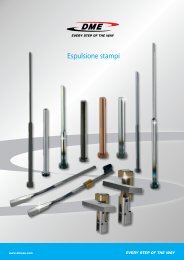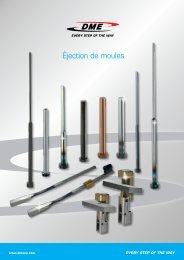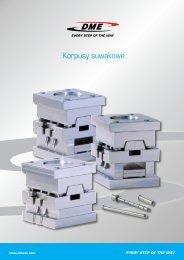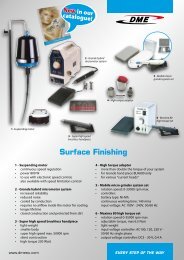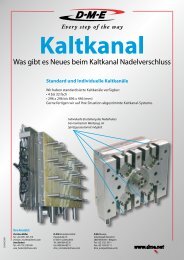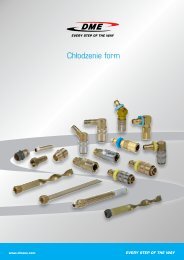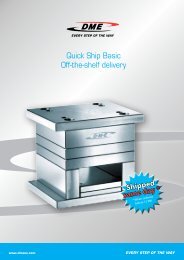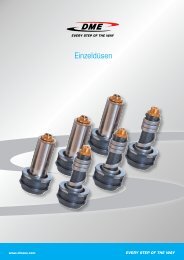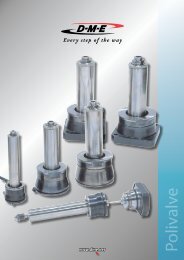COLM - DME
COLM - DME
COLM - DME
Create successful ePaper yourself
Turn your PDF publications into a flip-book with our unique Google optimized e-Paper software.
Accessories<br />
WL - WM - WH<br />
Evaporator<br />
WL 5° - 100° C<br />
WM 50° - 250° C<br />
WH 150° - 500° C<br />
58 - www.dmeeu.com<br />
Conductive grease<br />
General description<br />
The <strong>DME</strong> Heat Transfer Rods are static devices with very<br />
high thermal conductivity (over a thousand times greater<br />
than copper rods).<br />
It allows an important transmission of thermal power with a<br />
very low temperature gradient (a few degrees only).<br />
Operation<br />
<strong>DME</strong> Heat Transfer Rods work on the basis of latent heat<br />
with a difference of only about 10°C in temperature between<br />
each end.<br />
At the “hot” end of the tube, the liquid evaporates and absorbs<br />
energy. The resulting vapour moves to the “cold” end<br />
of the tube, where it condenses and releases energy. The<br />
liquid then flows back to the other end by gravity and capillary<br />
action. The latter occurs over a mesh inside the rod.<br />
<strong>DME</strong> Service<br />
<strong>DME</strong> provides recommendations on the most efficient use<br />
of Heat Transfer Rods in injection moulding or diecasting<br />
applications. In most cases, an application analysis will determine<br />
the estimated cycle time.<br />
Just fill out and fax or email the attached questionnaire.<br />
Our application engineers will submit a suitable quotation<br />
by return.<br />
Application<br />
Heat Transfer Rods are used in the following industries:<br />
- Die casting<br />
- Injection moulding for:<br />
a) Cooling (molds)<br />
b) Pre-heating of material<br />
c) Leveling of service temperatures<br />
Heat Transfer Rods<br />
Sheath Capillary wick<br />
Condensor<br />
WLG 5° - 100° C<br />
WMG 50° - 250° C<br />
WHG 150° - 500° C<br />
Advantages<br />
1. Simplified mold construction<br />
The <strong>DME</strong> Heat Transfer Rods are used in cores, core<br />
slides, cavities and other areas of a mold or die requiring<br />
cooling or controlled temperatures. In addition, the<br />
ability to locate Heat Transfer Rods in areas inaccessible<br />
to other cooling devices can further simplify the overall<br />
mold design.<br />
In most of the cases, the machining and construction<br />
time required for the mould is reduced, thus lowering<br />
mould making costs.<br />
2. Faster cycle times<br />
The cooling lines, throughout the entire mould can be<br />
larger in diameter, permitting a higher cooling velocity.<br />
A larger volume of fluid flowing through the cooling<br />
lines results in a lower overall coolant temperature rise.<br />
The ability to transfer heat away from the otherwise inaccessible<br />
areas improves the overall cooling rate and<br />
reduces the cycle time.<br />
3. Improved product quality<br />
The Heat Transfer Rod transfers heat to the coolant,<br />
air or mold components, it also dissipates heat evenly<br />
along its entire length. This isotherm action provides<br />
faster and more uniform cooling, thus eliminating hot<br />
spots which cause sink marks, pulling and spotting.<br />
4. Reduced maintenance costs<br />
The increased waterline diameter, coolant velocity and<br />
heat capacity eliminate scale formation. Consequently,<br />
cooling system maintenance and overall operating costs<br />
are almost nil.<br />
5. Retrofit in existing molds and dies<br />
In addition to their many applications Heat Transfer<br />
Rods have been retrofitted as replacement parts for<br />
bubblers of baffles and provide heat transfer in previously<br />
uncooled areas.<br />
17/07/2012



